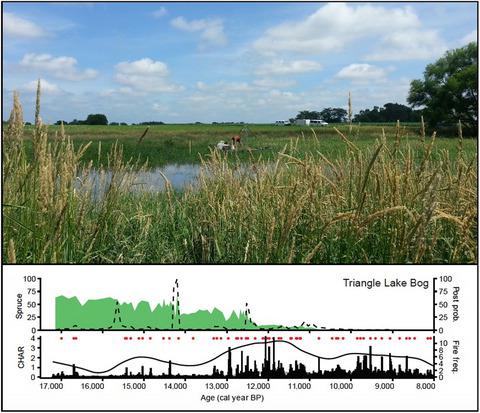Our official English website, www.x-mol.net, welcomes your
feedback! (Note: you will need to create a separate account there.)
More than one way to kill a spruce forest: The role of fire and climate in the late‐glacial termination of spruce woodlands across the southern Great Lakes
Journal of Ecology ( IF 5.3 ) Pub Date : 2020-10-08 , DOI: 10.1111/1365-2745.13517 Allison M. Jensen 1, 2 , David Fastovich 3 , Ben I. Watson 4 , Jacquelyn L. Gill 5 , Stephen T. Jackson 6 , James M. Russell 7 , Joseph Bevington 8 , Katherine Hayes 9 , Katherine B. Lininger 10 , Claire Rubbelke 3 , Grace C. Schellinger 11 , John W. Williams 3
中文翻译:

杀死云杉林的不止一种方法:大火和气候在大湖南部横跨云杉林地的晚期冰川终结中的作用
更新日期:2020-10-08
Journal of Ecology ( IF 5.3 ) Pub Date : 2020-10-08 , DOI: 10.1111/1365-2745.13517 Allison M. Jensen 1, 2 , David Fastovich 3 , Ben I. Watson 4 , Jacquelyn L. Gill 5 , Stephen T. Jackson 6 , James M. Russell 7 , Joseph Bevington 8 , Katherine Hayes 9 , Katherine B. Lininger 10 , Claire Rubbelke 3 , Grace C. Schellinger 11 , John W. Williams 3
Affiliation

|
- In the southern Great Lakes Region, North America, between 19,000 and 8,000 years ago, temperatures rose by 2.5–6.5°C and spruce Picea forests/woodlands were replaced by mixed‐deciduous or pine Pinus forests. The demise of Picea forests/woodlands during the last deglaciation offers a model system for studying how changing climate and disturbance regimes interact to trigger declines of dominant species and vegetation‐type conversions.
- The role of rising temperatures in driving the regional demise of Picea forests/woodlands is widely accepted, but the role of fire is poorly understood. We studied the effect of changing fire activity on Picea declines and rates of vegetation composition change using fossil pollen and macroscopic charcoal from five high‐resolution lake sediment records.
- The decline of Picea forests/woodlands followed two distinct patterns. At two sites (Stotzel‐Leis and Silver Lake), fire activity reached maximum levels during the declines and both charcoal accumulation rates and fire frequency were significantly and positively associated with vegetation composition change rates. At these sites, Picea declined to low levels by 14 kyr BP and was largely replaced by deciduous hardwood taxa like ash Fraxinus, hop‐hornbeam/hornbeam Ostrya/Carpinus and elm Ulmus. However, this ecosystem transition was reversible, as Picea re‐established at lower abundances during the Younger Dryas.
- At the other three sites, there was no statistical relationship between charcoal accumulation and vegetation composition change rates, though fire frequency was a significant predictor of rates of vegetation change at Appleman Lake and Triangle Lake Bog. At these sites, Picea declined gradually over several thousand years, was replaced by deciduous hardwoods and high levels of Pinus and did not re‐establish during the Younger Dryas.
- Synthesis. Fire does not appear to have been necessary for the climate‐driven loss of Picea woodlands during the last deglaciation, but increased fire frequency accelerated the decline of Picea in some areas by clearing the way for thermophilous deciduous hardwood taxa. Hence, warming and intensified fire regimes likely interacted in the past to cause abrupt losses of coniferous forests and could again in the coming decades.
中文翻译:

杀死云杉林的不止一种方法:大火和气候在大湖南部横跨云杉林地的晚期冰川终结中的作用
- 在19,000至8,000年前的北美大湖区南部,温度上升了2.5-6.5°C,云杉的云杉林/林地被落叶落叶松木或松树松林所取代。在上一次冰消作用期间,云杉林/林地的灭绝提供了一个模型系统,用于研究气候变化和干扰机制如何相互作用以触发优势物种和植被类型转换的衰退。
- 高温在推动云杉林/林地的区域灭亡中的作用已被广泛接受,但对火的作用了解甚少。我们使用化石花粉和宏观木炭从五种高分辨率湖泊沉积物记录中研究了火势变化对云杉下降和植被组成变化速率的影响。
- 云杉林/林地的衰退遵循两种不同的模式。在下降的两个地点(Stotzel-Leis和Silver Lake),火势活动在下降期间达到最高水平,木炭积累率和着火频率均与植被组成变化率显着正相关。在这些地点,白云杉到14年BP下降到较低水平,并被落叶硬木类群如灰白蜡木,蛇麻木/鹅耳Ost Ostrya / Carpinus和榆木Ulmus所取代。但是,这种生态系统的转变是可逆的,因为在年轻的树蛙时期,云杉以较低的丰度重新建立。
- 在其他三个地点,木炭积累与植被组成变化率之间没有统计关系,尽管火灾频率是阿普曼湖和三角湖沼泽植被变化率的重要预测指标。在这些地点,云杉在数千年中逐渐下降,被落叶阔叶树和高含量的松树所取代,并且在年轻树妖中没有恢复。
- 综合。在上一次冰消期,由于气候导致的云杉林地的消失,似乎并不需要开火,但是增加的着火频率通过清除嗜热落叶硬木类群的道路,加速了云杉在某些地区的衰落。因此,在过去,变暖和加剧的火势可能相互作用,导致针叶林突然丧失,并可能在未来几十年再次消失。











































 京公网安备 11010802027423号
京公网安备 11010802027423号